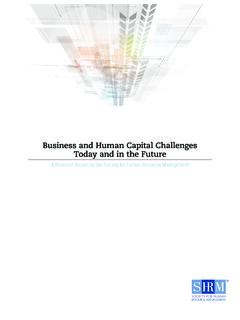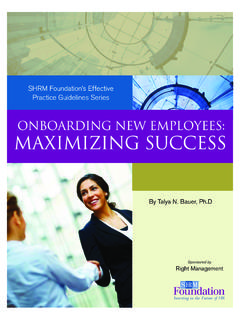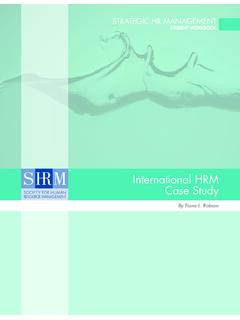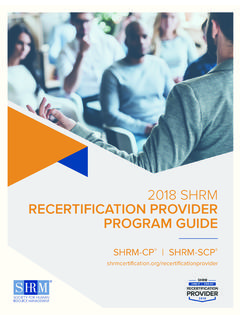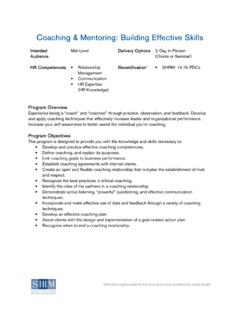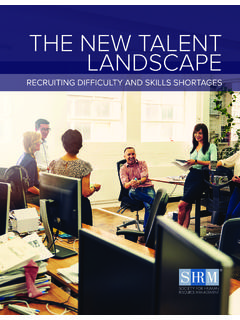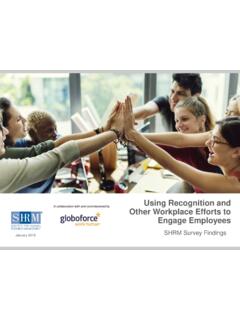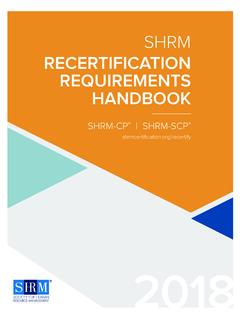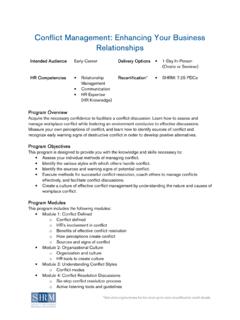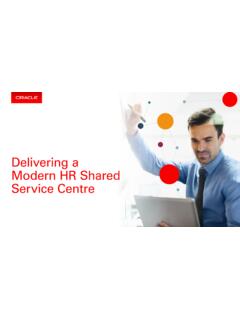Transcription of SHRM HR Metrics - Society for Human Resource …
1 SHRM HR Metrics Change Management: Leading Successful Transformations 2019 Society for Human Resource Management Page 1 HR Metrics (based on Functional Areas) Table of Contents Metrics Introduction .. 1 Strategic 2 Return 2 HR Management .. 3 Financial Management .. 4 Workforce Planning and Staffing .. 6 Staffing .. 6 Talent Management .. 10 Development .. 10 Training .. 10 Performance Management .. 11 Succession Planning .. 12 Total Rewards .. 12 Pay .. 12 Benefits .. 13 Employee Relations .. 14 Organizational Effectiveness.
2 14 EEO Compliance .. 15 Risk Management .. 15 Safety and Health .. 15 Liability .. 15 SHRM HR Metrics Change Management: Leading Successful Transformations 2019 Society for Human Resource Management Page 1 Metrics Introduction Included in this Job Aid are suggested Metrics for each of the HR functional areas. Several important points should be noted about the use of Metrics in HR and Human Capital management. First, Metrics are only truly useful when they provide a basis for analysis. They should not be used separate of analysis for any purpose other than compliance reporting, and even then it is encouraged that a thorough analysis of the data accompanies the reporting to insure a fuller understanding.
3 Applying basic statistical techniques, doing dimensional segmentation, and/or trending one metric to another, or to a target or benchmark is sufficient to turn Metrics into analytics and information into insight. It is the insight that produces value, not the metric itself. Reporting is insufficient, and it could be argued a complete waste of time. Analysis is necessary and critical. Second, the primary purpose of analytics is to support and improve decision making. Any metric that does not lead to action is not worth the time and effort to calculate and report it.
4 Typically today HR departments overproduce data and information yet provide little to no insight that achieves this primary purpose. Less is more when it comes to Metrics and analytics. Third, identify the appropriate audience for each metric. Many Metrics are useful to those responsible to manage an HR process because they provide insights into process improvement opportunities. But these Metrics may not be useful or important to line management. Other Metrics successfully illuminate risks to organization success and therefore provide valuable insight to your executive team.
5 Don t waste anyone s time with Metrics or analytics that are not relevant to their responsibilities and decisions. Fourth, with most Metrics there is no one defined desirable outcome. Organizations must set desired outcomes, or targets, for Metrics that align with organization strategy, goals, and objectives. The target must be such that it reasonable leads to organization success. Finally, identifying the handful of analytics that connect Human Capital management to organization strategy and key goals and objectives is the most important step you can take in making Metrics meaningful to your organization.
6 SHRM s course on Critical Evaluation: Building HR Metrics to Guide Decisions shows you how to do this. SHRM HR Metrics Change Management: Leading Successful Transformations 2019 Society for Human Resource Management Page 2 Strategic Management Return Analyses Break even Point The point in time when costs invested in developing or improving an HR program is equal to or greater than the returns. In other words, the break even point is reached when returns to date are equal to investments. Formula Development cost/Annual return Example A new on line training program has a development cost of $100,000.
7 It is expected to generate a return of $50,000 in reduced delivery costs each year. Break even point = $100,000 / $50,000 = 2 years Cost Benefit Ratio How the Benefits of a program or activity relate to the Costs associated with developing and executing that program or activity. When you are calculating Costs for any HR program be clear as to what you have included. In our example here we have included the salary + benefit costs for a new program lead and the use of a consultant to help develop the new program and make the systems changes to our HRIS necessary to capture Successor and High Potential identification.
8 We have not included the cost of the time of managers and HRBPs to participate in the program. Example The new succession management program will produce a savings of $500,000 in reduced search firm fees over the targeted time frame (2 years) and will cost $250,000 to develop and manage over that same period. Cost benefit ratio = $500,000:$250,000 = 2:1 Total Cost Benefit ratio is 2 to 1. SHRM HR Metrics Change Management: Leading Successful Transformations 2019 Society for Human Resource Management Page 3 ROI (Return on Investment) The return on a company s monetary investment in a new program or activity or change to a current program or activity.
9 The measurement of ROI can be calculated in several ways. If your organization has a standard formula, it s best to use that formula. If not, this formula can work for most situations. Anticipated Benefits can be ascertained by looking at potential reductions in the costs of administering and delivering the program ( , reduced vendor fees, lower headcount needed to administer), increases in productivity or reductions in costs enabled by the methodology or other aspect of the program ( , less time away from work and reduced travel expenses by putting a program on line), and improved outcomes ( , reducing turnover and employee relations issues, and increasing employee productivity with a better leadership program).
10 Quantify these benefits as much as possible. Costs and Benefits must be calculated for a set period of time that represents a reasonable life time for the program. A complete ROI analysis should also highlight those benefits that cannot be financially quantified but still represent desired outcomes. Formula ((Anticipated Benefits Total Development Cost of Program)/ Total Development Cost of Program) x 100 HR Management HR Expense to Revenue Ratio This information is useful for fiscal budgeting. To have this for each fiscal year creates a standard for projected budgeting costs for each year on HR expenses.
